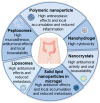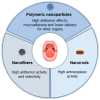Nanostructured Formulations for a Local Treatment of Cancer: A Mini Review About Challenges and Possibilities
- PMID: 40006574
- PMCID: PMC11859672
- DOI: 10.3390/pharmaceutics17020205
Nanostructured Formulations for a Local Treatment of Cancer: A Mini Review About Challenges and Possibilities
Abstract
Cancer represents a significant societal, public health, and economic challenge. Conventional chemotherapy is based on systemic administration; however, it has current limitations, including poor bioavailability, high-dose requirements, adverse side effects, low therapeutic indices, and the development of multiple drug resistance. These factors underscore the need for innovative strategies to enhance drug delivery directly to tumours. However, local treatment also presents significant challenges, including the penetration of the drug through endothelial layers, tissue density in the tumour microenvironment, tumour interstitial fluid pressure, physiological conditions within the tumour, and permanence at the site of action. Nanotechnology represents a promising alternative for addressing these challenges. This narrative review elucidates the potential of nanostructured formulations for local cancer treatment, providing illustrative examples and an analysis of the advantages and challenges associated with this approach. Among the nanoformulations developed for the local treatment of breast, bladder, colorectal, oral, and melanoma cancer, polymeric nanoparticles, liposomes, lipid nanoparticles, and nanohydrogels have demonstrated particular efficacy. These systems permit mucoadhesion and enhanced tissue penetration, thereby increasing the drug concentration at the tumour site (bioavailability) and consequently improving anti-tumour efficacy and potentially reducing adverse effects. In addition to studies indicating chemotherapy, nanocarriers can be used as a theranostic approach and in combination with irradiation methods.
Keywords: cancer; local treatment; nanoformulations; nanotechnology.
Conflict of interest statement
The authors declare no conflicts of interest.
Figures








References
Publication types
LinkOut - more resources
Full Text Sources

